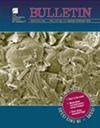Evidence for large Holocene earthquakes along the Yangsan fault in the SE Korean Peninsula revealed in three-dimensional paleoseismic trenches
IF 3.9
1区 地球科学
Q1 GEOSCIENCES, MULTIDISCIPLINARY
引用次数: 0
Abstract
The Yangsan fault is the most prominent NNE-SSW−striking active right-lateral strike-slip fault crossing the Korean Peninsula, with a continuous trace of ∼200 km. It can likely generate large earthquakes; however, the paleoseismic information on slip per event, slip rate, and timing of past ruptures along this fault remains sparse. To explore these parameters for the Yangsan fault, we excavated trenches across the central segment of the fault, which showed evidence for at least five surface-rupturing earthquakes preserved in Quaternary fluvial deposits. The timing of these earthquakes is discussed based on luminescence and radiocarbon ages. A close examination of three-dimensional trench exposures revealed that the most recent event(s) occurred during or slightly after the third century CE (one-event interpretation) or sixth to eighth century CE (two-event interpretation), and it was associated with 4.5 m to 5.3 m of lateral displacement of a paleochannel. The observed lateral displacement indicates that large earthquakes with a magnitude of around Mw 7 have taken place in the recent past, which is the first-ever direct evidence of large-magnitude earthquakes along the Yangsan fault. The penultimate event occurred after 17 ± 1 ka, whereas an earlier late Quaternary event occurred in the late Pleistocene, suggesting a recurrence interval in the range of 10,000 yr, and a consequent slip rate on the order of 0.5 mm/yr. The oldest observed ruptures are preserved below an erosional unconformity that probably dates back to the last interglacial period, based on infrared stimulated luminescence ages. An unknown number of ruptures may have occurred between the unconformity and subsequent sedimentation during the latest Pleistocene to Holocene period. Historical earthquake records indicate clustered behavior of moderate and large earthquakes along the Yangsan fault. Past faulting events and implied recurrence intervals constrain the long-term faulting behavior along the Yangsan fault and will contribute to a better seismic hazard assessment in the southeastern part of the Korean Peninsula.三维古地震沟揭示的朝鲜半岛东南部梁山断层全新世大地震证据
梁山断层是横跨朝鲜半岛的最突出的东北-西南走向活动右侧走向滑动断层,其连续走向长达 200 千米。它很可能会引发大地震;然而,关于该断层每次滑动、滑动速率和过去断裂时间的古地震信息仍然稀少。为了探究阳山断层的这些参数,我们挖掘了横跨断层中心段的沟槽,发现在第四纪河流沉积物中至少保存了五次地表破坏性地震的证据。根据发光年龄和放射性碳年龄对这些地震的发生时间进行了讨论。对三维坑道揭露的仔细研究表明,最近的地震发生在公元三世纪或稍后(一次地震解释)或公元六至八世纪(两次地震解释),与古河道 4.5 米至 5.3 米的横向位移有关。观测到的横向位移表明,近代曾发生过震级约为 7 级的大地震,这是阳山断层有史以来第一次发生大震级地震的直接证据。倒数第二次地震发生在 17±1 ka 之后,而更早的第四纪晚期地震发生在更新世晚期,这表明地震的重现间隔在 10,000 年左右,因此滑动速率约为 0.5 毫米/年。观测到的最古老的断裂保存在侵蚀性不整合地层之下,根据红外激发发光年龄,该不整合地层可能可以追溯到上一个间冰期。在最近的更新世到全新世期间,在该不整合地层与随后的沉积之间可能发生过数量不明的断裂。历史地震记录显示,阳山断层沿线发生过多次中、大型地震。过去的断层事件和隐含的重现间隔制约了梁山断层的长期断层行为,将有助于更好地评估朝鲜半岛东南部的地震灾害。
本文章由计算机程序翻译,如有差异,请以英文原文为准。
求助全文
约1分钟内获得全文
求助全文
来源期刊

Geological Society of America Bulletin
地学-地球科学综合
CiteScore
9.30
自引率
8.20%
发文量
159
审稿时长
4-8 weeks
期刊介绍:
The GSA Bulletin is the Society''s premier scholarly journal, published continuously since 1890. Its first editor was William John (WJ) McGee, who was responsible for establishing much of its original style and format. Fully refereed, each bimonthly issue includes 16-20 papers focusing on the most definitive, timely, and classic-style research in all earth-science disciplines. The Bulletin welcomes most contributions that are data-rich, mature studies of broad interest (i.e., of interest to more than one sub-discipline of earth science) and of lasting, archival quality. These include (but are not limited to) studies related to tectonics, structural geology, geochemistry, geophysics, hydrogeology, marine geology, paleoclimatology, planetary geology, quaternary geology/geomorphology, sedimentary geology, stratigraphy, and volcanology. The journal is committed to further developing both the scope of its content and its international profile so that it publishes the most current earth science research that will be of wide interest to geoscientists.
文献相关原料
| 公司名称 | 产品信息 | 采购帮参考价格 |
|---|
 求助内容:
求助内容: 应助结果提醒方式:
应助结果提醒方式:


